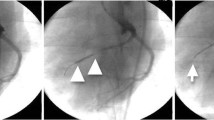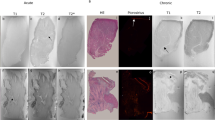Abstract
Purpose
To compare a necrosis-avid contrast agent (NACA) bis-Gd-DTPA-pamoic acid derivative (ECIII-60) after intracoronary delivery with an extracellular agent Gd-DTPA after intravenous injection on magnetic resonance imaging (MRI) in a swine model of acute reperfused myocardial infarction (MI).
Methods
Eight pigs underwent 90 min of transcatheter coronary balloon occlusion and 60 min of reperfusion. After intravenous injection of Gd-DTPA at a dose of 0.2 mmol/kg, all pigs were scanned with T1-weighted MRI until the delayed enhancement of MI disappeared. Then they were intracoronarily infused with ECIII-60 at 0.0025 mmol/kg and imaged for 5 hr. Signal intensity, infarct-over-normal contrast ratio and relative infarct size were quantified, compared, and correlated with the results of postmortem MRI and triphenyltetrazolium chloride (TTC) histochemical staining.
Results
A contrast ratio over 3.0 was induced by both Gd-DTPA and ECIII-60. However, while the delayed enhancement with Gd-DTPA virtually vanished in 1 hr, ECIII-60 at an 80× smaller dose depicted the MI accurately over 5 hr as proven by ex vivo MRI and TTC staining.
Conclusion
Both Gd-DTPA and ECIII-60 strongly enhanced acute MI. Comparing with fading contrast in a narrow time window with intravenous Gd-DTPA, intracoronary ECIII-60 persistently demarcated the acute MI, indicating a potential method for postprocedural assessment of myocardial viability after coronary interventions.





Similar content being viewed by others

References
Hillenbrand HB, Kim RJ, Parker MA, Fieno DS, Judd RM (2000) Early assessment of myocardial salvage by contrast-enhanced magnetic resonance imaging. Circulation 102:1678–1683
Heusch G, Schulz R (1997) Characterization of hibernating and stunned myocardium. Eur Heart J 18 (Suppl D):D102–110
Darius H, Buerke M, Lindemann S, et al (1997) Mechanism of reperfusion damage after thrombolysis and “direct PTCA”. Fibrinol Proteol 11(Suppl 2):117–121
Maxwell SRJ, Lip GYH (1997) Reperfusion injury: A review of the pathophysiology, clinical manifestations and therapeutic options. Int J Cardiol 58:95–117
Iskandrian AS (1996) Myocardial viability: Unresolved issues. J Nucl Med 37:794–797
Kaul S (1995) There may be more to myocardial viability than meets the eye. Circulation 92:2790–2793
Bremerich J, Saeed M, Arheden H, Higgins CB, Wendland MF (2000) Normal and infarcted myocardium: Differentiation with cellular uptake of manganese at MR imaging in a rat model. Radiology 216:524–530
Krombach GA, Saeed M, Higgins CB, Novikov V, Wendland MF (2004) Contrast-enhanced MR delineation of stunned myocardium with administration of MnCl2 in rats. Radiology 230:183–190
Weissleder R, Lee AS, Khaw BA, Shen T, Brady TJ (1992) Antimyosin-labeled monocrystalline iron oxide allows detection of myocardial infarct: MR antibody imaging. Radiology 182:381–385
Weinmann HJ, Ebert W, Misselwitz B, Schmitt-Willich H (2003) Tissue-specific MR contrast agents. Eur J Radiol 46:33–44
Pereira RS, Prato FS, Wisenberg G, Sykes J, Yvorchuk KJ (2001) The use of Gd-DTPA as a marker of myocardial viability in reperfused acute myocardial infarction. Int J Cardiovasc Imaging 17:395–404
Ramani K, Judd RM, Holly TA, Parrish TB, Rigolin VH, Parker MA, Callahan C, Fitzgerald SW, Bonow RO, Klocke FJ (1998) Contrast magnetic resonance imaging in the assessment of myocardial viability in patients with stable coronary artery disease and left ventricular dysfunction. Circulation 98:2687–2694
Kim RJ, Wu E, Rafael A, Chen EL, Parker MA, Simonetti O, Klocke FJ, Bonow RO, Judd RM (2000) The use of contrast-enhanced magnetic resonance imaging to identify reversible myocardial dysfunction. N Engl J Med 343:1445–1453
Oshinski JN, Yang Z, Jones JR, Mata JF, French BA (2001) Imaging time after Gd-DTPA injection is critical in using delayed enhancement to determine infarct size accurately with magnetic resonance imaging. Circulation 104:2838–2842
Saeed M, Lund G, Wendland MF, Bremerich J, Weinmann H, Higgins CB (2001) Magnetic resonance characterization of the peri-infarction zone of reperfused myocardial infarction with necrosis-specific and extracellular nonspecific contrast media. Circulation 103:871–876
Choi CJ, Haji-Momenian S, Dimaria J (2002) Contrast washout by MRI identifies stunned myocardium in patients after reperfused myocardial infarction [abstract]. J Cardiovasc Magn Reson 4:19
Judd RM, Kim RJ, Oshinski JN, Yang Z, Jones JR, Mata J, French BA (2002) Imaging time after Gd-DTPA injection is critical in using delayed enhancement to determine infarct size accurately with magnetic resonance imaging [with response]. Circulation 106(2):e6–6
Ni Y, Bormans G, Chen F, Verbruggen A, Marchal G (2005) Necrosis avid contrast agents: Functional similarity versus structural diversity. Invest Radiol 40:526–535
Ni Y, Marchal G, Petré C, Lukito G, Herijgers P, Flameng W, Yu J, Hilger CS, Ebert W, Maier FK, Semmler W (1994) Metalloporphyrin enhanced magnetic resonance imaging of acute myocardial infarction. Circulation 90, Part 2: I-468, abstract no. 2512
Marchal G, Ni Y, Herijgers P, Flameng W, Petré C, Bosmans H, Yu J, Ebert W, Hilger CS, Pfefferer D, Semmler W, Baert AL (1996) Paramagnetic metalloporphyrins: Infarct avid contrast agents for diagnosis of acute myocardial infarction by MRI. Eur Radiol 6:2–8
Pislaru S, Ni Y, Pislaru C, Bosmans H, Miao Y, Bogaert J, Semmler W, Marchal G, Van de Werf F (1999) Noninvasive measurements of infarct size after thrombolysis with a necrosis-avid MRI contrast agent. Circulation 99:690–696
Ni Y, Pislaru C, Bosmans H, Pislaru S, Miao Y, Van de Werf F, Semmler W, Baert AL, Marchal G (1998) Validation of intracoronary delivery of metalloporphyrin as an in vivo “histochemical staining” for myocardial infarction with MR imaging. Acad Radiol 5(Suppl 1):37–41
Saeed M, Bremerich J, Wendland MF, Wyttenbach R, Weinmann HJ, Higgins CB (1999) Reperfused myocardial infarction as seen with use of necrosis-specific versus standard extracellular MR contrast media in rats. Radiology 213:247–257
Choi SI, Choi SH, Kim ST, Lim KH, Lim CH, Gong GY, Kim HY, Weinmann HJ, Lim TH (2000) Irreversibly damaged myocardium at MR imaging with a necrotic tissue-specific contrast agent in a cat model. Radiology 215:863–868
Ni Y, Pislaru C, Bosmans H, Pislaru S, Miao Y, Bogaert J, Dymarkowski S, Yu J, Semmler W, Van de Werf F, Baert AL, Marchal G (2001) Intracoronary delivery of Gd-DTPA and Gadophrin-2 for determination of myocardial viability with MR imaging. Eur Radiol 11:876–883
Barkhausen J, Ebert W, Debatin JF, Weinmann HJ (2002) Imaging of myocardial infarction: Comparison of magnevist and gadophrin-3 in rabbits. J Am Coll Cardiol 39:1392–1398
Saeed M, Wendland MF, Bremerich GL, Weinmann HJ, Higgins CB Assessment of myocardial viability using standard extracellular and necrosis specific MR contrast media. Acad Radiol 9(Suppl 1): S84–87
Lee SS, Goo HW, Park SB, Lim CH, Gong G, Seo JB, Lim TH (2003) MR imaging of reperfused myocardial infarction: Comparison of necrosis-specific and intravascular contrast agents in a cat model. Radiology 226:739–747
Marchal G, Verbruggen A, Ni Y, Adriaens P, Cresens E (1999) Non-porphyrin compounds for use as a diagnosticum and/or pharmaceutical. International Patent Application. PTC/BE99/00104; Filing date: August 5, 1999
Cresens E, Ni Y, Adriaens P, Verbruggen A, Marchal G (2001) Substituted bis-indole derivatives useful as contrast agents, pharmaceutical compositions containing them and intermediates for producing them. International Patent Application PCT/BE01/00192, Filing date November 7, 2001
Ni Y, Cresens E, Adriaens P, Dymarkowski S, Bogaert J, Zhang H, Bosmans H, Verbruggen A, Marchal G (2002) Exploring multifunctional features of necrosis avid contrast agents. Acad Radiol 9 (Suppl 2):S488–490
Ni Y, Cresens E, Adriaens P, Miao Y, Verbeke K, Dymarkoski S, Verbruggen A, Marchal G (2002) Necrosis-avid contrast agents: Introducing nonporphyrin species. Acad Radiol 9(Suppl 1):S98–S101
http://www.mr-tip.com/serv1.php?type=db1&dbs=Necrosis%20Avid%20Contrast%a20Agent Magnetic Resonance - Technology Information Portal, accessed on December 12, 2005
Allman KC, Shaw LJ, Hachamovitch R, Udelson JE (2002) Myocardial viability testing and impact of revascularization on prognosis in patients with coronary artery disease and left ventricular dysfunction: A meta-analysis. J Am Coll Cardiol 39:1151–1158
Krombach GA, Kinzel S, Mahnken AH, Gunther RW, Buecker A (2005) Minimally invasive close-chest method for creating reperfused or occlusive myocardial infarction in swine. Invest Radiol 40:14–18
Simonetti OP, Kim RJ, Fieno DS, Hillenbrand HB, Wu E, Bundy JM, Finn JP, Judd RM (2001) An improved MR imaging technique for the visualization of myocardial infarction. Radiology 218:215–223
Gupta A, Lee VS, Chung YC, Babb JS, Simonetti OP (2004) Myocardial infarction: Optimization of inversion times at delayed contrast-enhanced MR imaging. Radiology 233:921–926
Bremer C, Bankert J, Filler T, Ebert W, Tombach B, Reimer P (2005) High-dose Gd-DTPA vs Bis-Gd-mesoporphyrin for monitoring laser-induced tissue necrosis. J Magn Reson Imaging 21:801–808
Ni Y, Huyghe D, Verbeke K, de Witte PA, Nuyts J, Mortelmans L, Chen F, Marchal G, Verbruggen AM, Bormans GM (2006) First evaluation of mono- [123I]iodohypericin as a necrosis avid tracer agent. Eur J Nucl Med 33(5):595–601
Hofmann B, Bogdanov A Jr, Marecos E, Ebert W, Semmler W, Weissleder R (1999) Mechanism of gadophrin-2 accumulation in tumor necrosis. J Magn Reson Imaging 9:336–341
Ni Y, Adzamli K, Miao Y, Cresens E, Yu J, Periasamy MP, Adams MD, Marchal G (2001) MRI contrast enhancement of necrosis by MP-2269 and gadophrin-2 in a rat model of liver infarction. Invest Radiol 36:97–103
Ni Y, Chen F, Bormans G, Verbruggen A, Marchal G (2005) Targeting stroma: Natural mechanisms derived from photodynamic therapy (PDT) and necrosis avid contrast agents (NACAs)? Molecular Imaging 4:382, abstract no. 556
Huber AM, Schoenberg SO, Hayes C, Spannagl B, Engelmann MG, Franz WM, Reiser MF (2005) Phase-sensitive inversion-recovery MR imaging in the detection of myocardial infarction. Radiology 237:854–860
Acknowledgments
This project is partially supported by a grant from the Scientifc And Technologic Fund (XJ 0590217) of Southeast University, Nan**g, China, and by the research fund of Ondersoeksfonds OT/96/33, University of Leuven, Belgium. We thank **ming Wei, PhD, Department of Statistics, School of Basic Medical Sciences, Southeast University, Nan**g, China, for his advice on the statistical analysis of the data.
Author information
Authors and Affiliations
Corresponding author
Rights and permissions
About this article
Cite this article
**, J., Teng, G., Feng, Y. et al. Magnetic Resonance Imaging of Acute Reperfused Myocardial Infarction: Intraindividual Comparison of ECIII-60 and Gd-DTPA in a Swine Model. Cardiovasc Intervent Radiol 30, 248–256 (2007). https://doi.org/10.1007/s00270-006-0004-0
Published:
Issue Date:
DOI: https://doi.org/10.1007/s00270-006-0004-0



